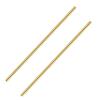An obstructed barrel most definitely does put the barrel at risk.
However, who says this is the first squib? More correctly, who says the bullet in the barrel was from the squib load? Unless it is the first round you have fired, all you know is that it is the last bullet in the barrel. You don't know if it was the first or not. You may not know if it is the only one or not. I will give you a real life example. We were shooting El Presidente drills. Bill was up and I was running the timer. Bill is working through the targets at a pretty good clip when his gun locks up on the 3rd target before the mag change. It had locked up because the barrel bulged and would not cycle. The barrel bulged with only one bullet in it, however. So now you are asking, how could a squib damage a barrel when it is a low pressure event? Simple. The bullet recovered wasn't the low pressure squib event. That, as it turns out, was the 1st or 2nd shot on target #1 as target #1 only had one hole in it. He had fired at least 4 or 5 more rounds before the gun locked up. What happened was that Shot 1 or 2 was a squib and went unnoticed. The next shot pushed out the squib and the next shot's bullet then became lodged in the barrel and became the new squib or stuck bullet. Think of it as a Newton's Cradle sort of event where the impacting ball forces the ball at the opposite end to move. This was repeated until the lockup at which time the last round fired managed to push out the previous squib, but the barrel started to outwardly fail and expanded with internal cracks that resulted in the outward bulge appearance. There was one visible external crack as well. We figure the bullet in the barrel was the 4th or 5th stuck bullet. So the barrel had undergone 4 or 5 cycles of overpressure between the bullets as the trailing bullet would be shot toward the back of the leading stuck bullet (maybe hitting or not) before the leading stuck bullet was forced out. This wrecked the barrel.
I will give you a second real life example. Who says you have only one "squib" in the barrel? We had a guy manage to lock up three rounds in a rifle barrel before he realized he had "A" squib. The outward appearance of the barrel was nominal. Somebody produced a brass rod and we could not get it tapped out. However, in putting the rod in from both ends, we were able to determine that the distances inserted came up nearly 2" short when added together, meaning there was a 2" obstruction in the barrel. The bullets aren't 2" long and it was determined that there was likely more than one bullet stuck in the barrel. So, he took the rifle to a gunsmith who ended up being unable to remove the bullets without cutting open the barrel, which he did, revealing the stuck bullets.
So do you really want to put a charge behind a squib before assessing the condition of the barrel and gun? Is that going to be the charge that produces the kaboom?


